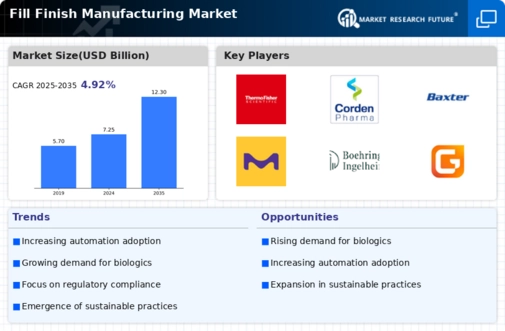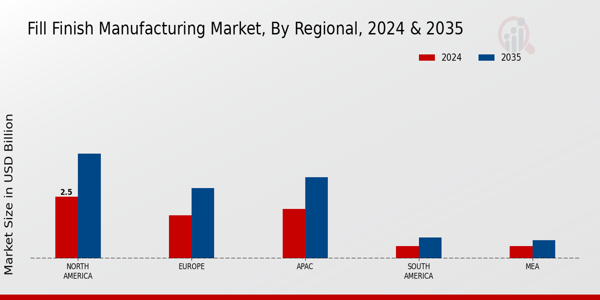Market Growth Projections
The Global Fill Finish Manufacturing Market Industry is poised for substantial growth, with projections indicating a market value of 7.25 USD Billion in 2024 and an anticipated increase to 12.3 USD Billion by 2035. This growth trajectory suggests a compound annual growth rate of 4.92% from 2025 to 2035, reflecting the industry's resilience and adaptability in meeting evolving market demands. Factors such as technological advancements, regulatory compliance, and the rising demand for biologics are likely to drive this growth. As the industry evolves, stakeholders must remain vigilant to capitalize on emerging opportunities and navigate potential challenges.
Increasing Demand for Biologics
The Global Fill Finish Manufacturing Market Industry experiences a notable surge in demand for biologics, driven by the growing prevalence of chronic diseases and the aging population. Biologics, which require precise fill finish processes to ensure stability and efficacy, are projected to significantly influence market dynamics. As of 2024, the market is valued at approximately 7.25 USD Billion, reflecting the increasing investments in biologics manufacturing. The need for advanced fill finish technologies to maintain product integrity and compliance with regulatory standards further propels this trend, indicating a robust growth trajectory for the industry.
Emerging Markets and Global Expansion
Emerging markets present substantial opportunities for growth within the Global Fill Finish Manufacturing Market Industry. Countries in Asia-Pacific and Latin America are witnessing increased investments in pharmaceutical manufacturing, driven by rising healthcare demands and improving infrastructure. These regions are becoming attractive destinations for fill finish manufacturing due to lower operational costs and favorable regulatory environments. As global pharmaceutical companies seek to expand their footprint, the focus on these emerging markets is likely to intensify. This trend could lead to a more diversified market landscape, with increased competition and innovation in fill finish technologies.
Technological Advancements in Automation
Technological advancements in automation play a crucial role in enhancing efficiency within the Global Fill Finish Manufacturing Market Industry. Automation technologies, including robotics and artificial intelligence, streamline production processes, reduce human error, and improve throughput. These innovations are particularly vital in the context of increasing production demands and stringent regulatory requirements. As manufacturers adopt automated solutions, they can achieve higher precision and consistency in fill finish operations. This trend is expected to contribute to the market's growth, with projections suggesting a compound annual growth rate of 4.92% from 2025 to 2035, indicating a shift towards more efficient manufacturing practices.
Regulatory Compliance and Quality Assurance
Regulatory compliance and quality assurance remain paramount in the Global Fill Finish Manufacturing Market Industry, as stringent regulations govern the production of pharmaceutical products. Manufacturers must adhere to guidelines set forth by health authorities to ensure product safety and efficacy. This necessity drives investment in quality control measures and advanced fill finish technologies that meet regulatory standards. The emphasis on quality assurance not only protects public health but also enhances the reputation of manufacturers. As the industry evolves, the focus on compliance is likely to shape operational strategies, ensuring that products meet the highest quality benchmarks.
Growth of Contract Manufacturing Organizations
The rise of Contract Manufacturing Organizations (CMOs) significantly influences the Global Fill Finish Manufacturing Market Industry. CMOs provide specialized services to pharmaceutical companies, allowing them to outsource fill finish processes and focus on core competencies. This trend is particularly beneficial for smaller companies that may lack the resources for in-house manufacturing. As the market expands, the collaboration between pharmaceutical firms and CMOs is expected to grow, facilitating access to advanced technologies and expertise. This partnership model not only enhances operational efficiency but also contributes to the overall market growth, with projections indicating a market value of 12.3 USD Billion by 2035.














